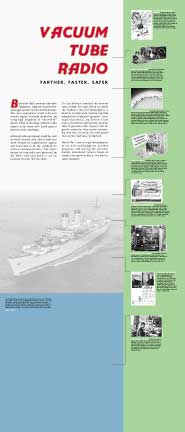
|
By the late 1920s, vacuum
tube radio equipment replaced the primitive spark-gap systems on most
merchant ships. This new equipment could send and receive signals virtually
worldwide, by using high frequency or "short-wave" bands.
Tube technology allowed radio signals to be tuned with much greater
precision than spark-gap.
Although tube equipment could be used for voice transmission, Morse
code was more reliable for long-distance signals and continued to be
the standard for marine communications. The basic design for tube radio
was perfected by the 1930s and continued in use on merchant vessels
into the 1980s.
Dr. Lee deForest invented the vacuum tube in 1906. His tube, which
he called the "audion," was first developed as a detector
of radio waves and was quickly adopted by shipboard operators. Later
experimentation, by deForest and others, showed the ability of the
vacuum tube to generate radio signals with far greater precision than
earlier systems. By 1914 the essentials of tube-based transmitters
had been worked out.
World War I led to rapid development of the new technology for military
purposes, and during the post-war decade tube-based systems began
to replace the spark system as the marine radio standard.
The troopship General John Pope was built in New Jersey
in 1943, the first of the "General" class of World War II
P2 troop carriers. Her radio equipment is in the case to your left.
The Pope served as a naval transport in the Pacific Theater
during WW II. She was reactivated as a Military Sea Transport Service
vessel during both the Korean and the Vietnam Wars. The Pope was laid-up at Suisun Bay in the early 1970s. Photo SFMNHP, P77-026A353n
.
|
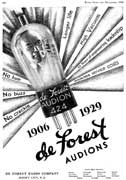 |
DEFOREST'S INVENTION OF THE "AUDION"
tube followed the work of earlier experimenters. Thomas Edison developed
the light bulb with its single filament in the 1880s, and Ambrose Fleming
added a metal plate to the bulb around 1900 to produce a detector of
radio waves. DeForest added a third element, a wire "grid"
which resulted in a vastly improved detector and ultimately the ability
to both amplify and generate electromagnetic energy. Ad from Radio
News, December, 1929. |
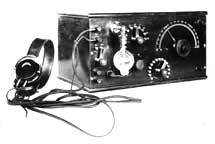 |
1915 DEFOREST "AUDION" TUBES
WERE USED
in receivers well before tube transmitters were introduced. Purchased
privately, sets like this deForest RJ-6 were used without company permission
by Marconi and RCA shipboard operators during the spark era. They were
much better than the equipment which the company provided. The receivers
had to be hidden away when the ship was in port so the company inspectors
would not see them. |
 |
1920s SHORT-WAVE RADIO SIGNALS.
The Iong-range potential of short-wave radio was not discovered until
the 1920s. These high-frequency signals ("short-wave" equals
high-frequency) could bounce along between the ionosphere and the ground
to achieve virtually worldwide range. Neither the low and medium-frequency
signals nor the very-high-frequency bands had this property. Initially
allocated for amateur use, the high frequency range was considered to
be of little practical use, but ultimately became the principal means
of long-distance communication. |
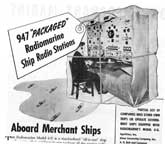 |
1940 THE RCA "4-U" RADIO,
named for its four units of receivers and transmitters, was one of the
standard console radio systems aboard merchant ships during World War
II. Console sets were produced by the Radiomarine division of RCA and
by the Mackay Radio division of IT&T. Using the vacuum tube technology
of the late 1930s, the 4-Us were large and heavy, but were suitable
for mass-production under wartime conditions and proved reliable through
adverse weather and enemy action. Ad from The Nautical Gazette,
April 1946. |
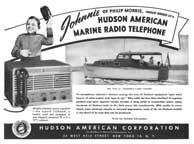 |
1946 SHORT-WAVE RADIOTELEPHONE SETS,
available for inshore vessels in the late-1930s, became common after
World War II. Operating on the 2 to 3 MC band, these compact short-wave
units had a range of about one hundred miles. The sets were used on
fishing boats, tugs and yachts. In the early 1950s, ocean steamers were
equipped with larger radiotelephone sets made by Mackay or Radiomarine.
In this 1946 ad, "Johnnie" the bellhop extols the Hudson American
set fitted on his cabin cruiser. Ad from Pacific Motorboat, June
1947. |
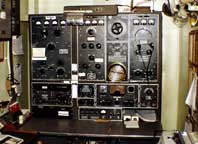 |
1950s THE POST-WAR MACKAY CONSOLE
was a smaller and more refined version of the time-tested tube technology
of the wartime models. Aficionados consider these sets the pinnacle
of a "Golden Age" of radio that pointed the way toward today's
compact radio systems. This radio was aboard the Chevron tanker Alaska
Standard, and used until 1985. Photo SFMNHP, Demeo collection. |
1965 SINGLE-SIDE BAND (SSB) RADIO
offered the first long-distance voice communication, and was developed
during the vacuum tube era. It only became widespread in marine use
when transistors replaced tubes, allowing the units to be much smaller
and more rugged. The early single-side band radio units, like this set
installed aboard the liner S.S. United States, were both large
and expensive. |
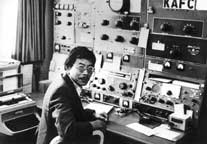 |
1982 RADIO OFFICER JOHN CHOW
in the radio room of the S.S. Santa Maria. He served for some
years as the West Coast head of the Radio Officers' Union. The Santa
Maria, built in 1963, sailed for the Delta Line on a South American
run and was among the last American passenger vessels. Her radio room
represents the last generation of marine radio-telegraphy gear. Photo
SFMNHP, Chow collection. |
|